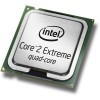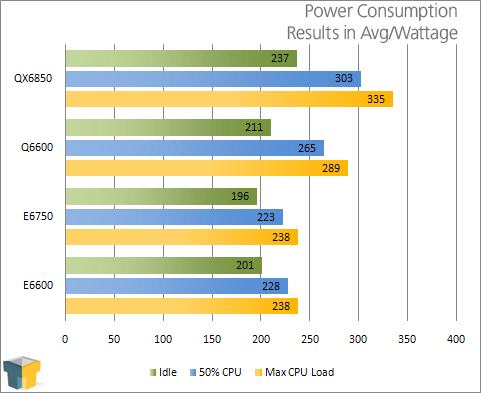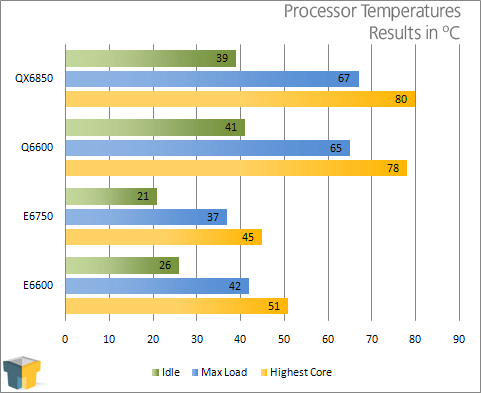- Qualcomm Launches Snapdragon 4 Gen 2 Mobile Platform
- AMD Launches Ryzen PRO 7000 Series Mobile & Desktop Platform
- Intel Launches Sleek Single-Slot Arc Pro A60 Workstation Graphics Card
- NVIDIA Announces Latest Ada Lovelace Additions: GeForce RTX 4060 Ti & RTX 4060
- Maxon Redshift With AMD Radeon GPU Rendering Support Now Available
Intel Core 2 Extreme QX6850 Quad-Core

Intel today is announcing their 1333FSB Core 2 line-up, which consists of three dual-cores, including the E6750 we previewed a few weeks ago, and also the 3.0GHz quad-core that we are testing out today. Read on as we explore all of what Intel’s latest flagship processor has to offer.
Page 10 – Power Consumption, Temperatures
As our processors become faster and more robust, power consumption can also increase. Thanks to the focus on efficiency though, current processors can use less power than models seen just two years ago. Like the QX6800, the QX6850 has a TDP of 130W, while our other quad-core, the Q6600 has a TDP of 105W. Both the E6750 and E6600 have a TDP of 65W, so the differences should be apparent.
We use a Kill-A-Watt in order to capture the wattages. At each setting, we eye the meter for around a minute in order to grab an average. Normally, the wattage will stay the same for the entire minute, once the computer either sits idle for a minute or two, or if the benchmarks are in full swing. Idle results are grabbed after the PC sits idle for two minutes, while the 50% CPU is with 50% of the available cores being stressed using SP2004. This would simulate more intensive applications that wouldn’t make use of more than half of the available processing power.
Lastly, for a full load recording, we run a copy of SP2004’s Small FFT test on each core, effectively keeping usage at a constant 100%. After a minute of watching the meter, the highest wattage point reached is recorded.

The first thing that stands out to me is that the E6750, oddly enough, uses less overall power at Idle and 50% than the slower E6600. But what matters here is the QX6850 results, which scaled as we expected when compared to the Q6600. Though both processors used the same amount of voltage, the faster 3.0GHz topped out 46W higher than the Q6600. When stressing the CPU and 8800GTX at the same time, the total power consumption couldn’t even break through 400W. Not bad for such a screaming fast setup.
When you cram four cores under the same IHS that usually houses two, temperatures are bound to skyrocket. This really means one thing… that you do not want to use a cheap air cooler. A high-quality air cooler should suffice, but for the enthusiast, water-cooling is really the only way to go.
For grabbing temperature information, I stick to using Everest 4.0, since it seems quite accurate. However, when bringing it up with Intel, we were told that there is no way for any application to have a completely accurate reading for Quad-Core temperatures, Everest and CoreTemp included.
Quad-Cores utilize what’s called a Digital Temperature Sensor, DTS for short, which provides an offset from the Prochot trip temperature. If the processor is 12°C away from activating the TCC and Prochot, then the reported temperature, behind the scenes, will be -12°C. Intel states that the reason exact temperatures cannot be determined is because they have not defined the precise temperature at which the TCC is activated. How it’s activated at all, I am not sure.
Temperatures gathered with quad-cores shouldn’t be considered accurate with any application, which leads me to wish that Intel offered a tool for finding the precise temperature. During testing though, when Everest reported a 80°C temperature for the entire CPU, I had my Type K diode against the side of the IHS which reported a temperature of 74°C. So because of this, I believe Everest is still in the right ball-park.
That leads to another thing, though. If your quad-core seems to hit 80°C on any core, it’s not really a cause for alarm, as they are designed in such a way to handle a fair amount of heat. If for whatever reason the CPU does get too hot, which I assume to be when the TCC and Prochot is activated, a reverse-EIST effect will occur, where the processor will automatically reduce the multiplier to 6 in order to reduce the clock speed and in turn, the temperature.

Interestingly enough, even though the QX6850 vastly surpasses the performance of the Q6600, it’s only kept 2°C hotter. As we will find out on the next page, even with the QX6850 overclocked to 3.337GHz, it topped out the same. So to reiterate, temperatures on Quad-Cores are far higher than dual cores, for obvious reasons. Although Everest’s results cannot be called completely accurate, it’s still wise to properly cool your CPU to give it a long life. But, if you are like many who visit this site who don’t mind shortening your CPU’s lifespan, overclocking is up next.
Support our efforts! With ad revenue at an all-time low for written websites, we're relying more than ever on reader support to help us continue putting so much effort into this type of content. You can support us by becoming a Patron, or by using our Amazon shopping affiliate links listed through our articles. Thanks for your support!





